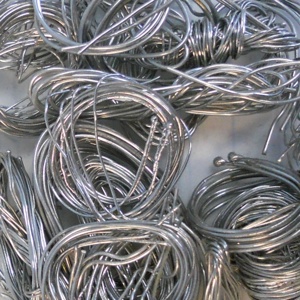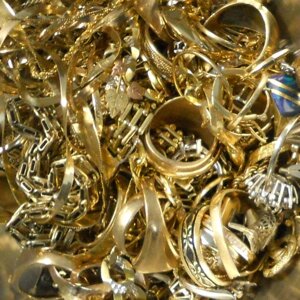Take These Steps to Avoid Being Poisoned by Platinum Scrap
Is platinum toxic?
In its pure form, platinum is inert and does not react with most chemicals or substances, including acids and bases. This property makes it highly resistant to corrosion and tarnish. Consequently, platinum is often used in medical and dental implants, such as pacemakers, stents, and dental crowns, due to its biocompatibility and resistance to corrosion.
What Platinum Alloys Are Found in Platinum Scrap?
When you go hunting for platinum scrap, chances are you are expecting to find scrap that is made of bright, white, shiny metal. And you’re right to be expecting that. After all, that is what platinum looks like.
But if you think that way, you are overlooking the fact that valuable platinum scrap is not always made of pure platinum. In fact, the scrap you are looking for will often be made of an alloy comprised of platinum and other metals. Those alloys might not be bright, white, and shiny. But make no mistake about it, those platinum alloys are well worth recycling.
Investing Lessons from the Most Valuable Pieces of Platinum Jewelry in History
Platinum Scrap Wisdom . . .
Investing Lessons from the Most Valuable Pieces of Platinum Jewelry in History
What Gold and Silver Is Found in Old Telescopes?
Old telescopes often feature various components made of gold and silver. Here are some common uses of these metals in vintage telescopes.
What Small Pieces of Jewelry Are Most Likely to be Made of Platinum?
If you are on the lookout for platinum – and you should be because, at the time of writing this post, the precious metal is currently trading for $1,334 per Troy Ounce – you should be looking for small items of jewelry that are made of the metal.
You can find several kinds of platinum jewelry at estate sales, junk shops, and even in the places where you store jewelry in your home.
What kinds of small pieces of jewelry are most likely to be made of platinum? Some examples include:
What You Need to Know about Recycling Platinum Group Metal Scrap
What are platinum group metals, where are they found and what are they used for?
Platinum group metals (PGMs) are a group of six metallic elements that belong to the platinum group on the periodic table.
Large Amounts of Platinum Scrap Could Be Hiding in Some Unusual Places
With platinum trading for $1,400/Troy Ounce today, it is well worth looking for it in unusual places. Even a small amount of certain kinds of scrap that will fit in a shoebox or in your pocket could bring you a much bigger profit than you expected.
What Is the Best Way to Securely Store Jewelry and Gold and Platinum Scrap in Your Home?
Hiding your jewelry and valuables in a place that is not secure, such as a dresser drawer or jewelry box, may not provide sufficient protection. Burglars often target these areas first because they know that jewelry is commonly kept there.
If you do choose to hide your jewelry in your home, make sure the hiding place is not easily discoverable. For example, do not hide your jewelry in a typical hiding spot like a sock drawer or under your mattress. Instead, consider a more creative hiding spot that is not as obvious.
What Do Precious Metal Refining Companies Do?
Precious metal refining companies specialize in the extraction and purification of precious metals, such as gold, silver, platinum, and palladium, from raw materials such as ore, electronic waste, and scrap metal.
Four Kinds of Platinum Scrap You Should Not Overlook
With platinum currently trading for $940.00 on the London Fix, it is a metal you should definitely not overlook as you make your plans as a precious metal investor.
But where can you find platinum scrap that we can recycle for you? Let’s review four of the best kinds of platinum scrap you should be focusing on.
How to Use a Metal Detector to Find Precious Metals: The Basics
We have written many articles about metal detectors on this blog, and with good reason.
Metal detectors, even basic models that cost little more than $100.00, are some of the most powerful tools ever devised for finding buried precious metals on beaches, in open fields, on the sites of old buildings and factories, and other prime prospecting sites.
People are making money – sometimes a lot of it – by using metal detectors. And chances are pretty good that you can too.
What Precious Metals Are Found in Meteorites?
We recently visited the Arthur Ross Hall of Meteorites at the American Museum of Natural History in New York. What a display!
More than 130 meteorites are displayed there, including the huge 34-ton Cape York Meteorite, also known as Ahnighito. That monstrous meteorite contains mostly iron.
That display got us wondering about the metallic content of all those meteorites, all of which had literally fallen from the sky. Did they contain gold or other precious metals?
Why It is Hard to Make Money in Iridium Scrap
Iridium, one of the platinum group metals, is worth a lot of money. It is trading at about $6,000 per Troy Ounce.
That’s a high trading price. But before you go hunting for this white shiny metal, please read our post today. Although iridium is worth a lot of money, it is really hard to find. So our advice to you is to understand iridium, but to place it low on the list of precious metals you are hunting for.
Where Can You Find Platinum Outdoors in North America?
If you go looking for gold or silver deposits outdoors, chances are good you will find small quantities of those precious metals. All you need is a metal detector, a gold panning kit or machinery, or other basic equipment. You might not find a tremendous amount of those metals during a typical day of prospecting. But you will find something – often enough to make your day of hunting worthwhile.
Platinum Scrap and Beyond . . . There Are Many Kinds of Sputtering Targets We Can Recycle for You
We have written about sputtering targets before on the Specialty Metals Blog. To review, they are multilayered disks that contain several different metals. When they are secured inside a plasma plating tank and electrical current flows through them, their uppermost layer of metal (be it gold, platinum, or another metal) is dispersed into the plasma inside the tank. Due to the flow of electrons, it adheres to the surface of whatever metal object is being plated.
Five Tips to Help You Recognize Platinum Scrap When You See It
Let’s start today’s article by asking you to answer this simple question about platinum . . .
When you go looking for platinum scrap, you should be looking for a bright, white, metal with a shiny surface. [ ] true [ ] false
You’ll be surprised to hear that the statement above is false!
Make Money Recycling Platinum, Gold, and Silver Wire
A few years ago, it was time to replace the muffler/silencer on a riding mower. The company that owned it ordered a new muffler and yanked the old one off. At that point, the owner noticed that it had been installed by wrapping wire around one of the pipes that came out of the old muffler.
That wire, which was about two feet long and weighed about 2/10 of a Troy Ounce, turned out to be made of pure platinum. It was worth more than $200.00.
Reasons to Refine Your Platinum Scrap
Let’s say you have a quantity of platinum scrap. It could be a few barrels full of old thermocouple wire, a batch of platinum wire you acquired from a jewelry factory that was going out of business, or even some old turbine blades from jet engines.
What You Need to Know about Environmentally Friendly Platinum Refining
If you have platinum scrap to refine, you could deliver it to a platinum refinery near where you live, walk away with a check for the amount of platinum that the refinery estimates your scrap contains, and never give it a second thought.
Make These Items with High Precious Metal Scrap Value Your Top Collecting Priority
A number of factors make certain kinds of precious metal scrap more desirable investments than others.
These factors include the density and distribution of precious metal within the scrap. If one ounce of gold is distributed through two pounds of scrap, for example, that is a desirably, high density form of scrap. If that same single ounce of gold is distributed through two tons of dirt or sand, that makes for a less desirable investment. (It is easier to ship and process two pounds of material than it is to ship and process two tons.)




















